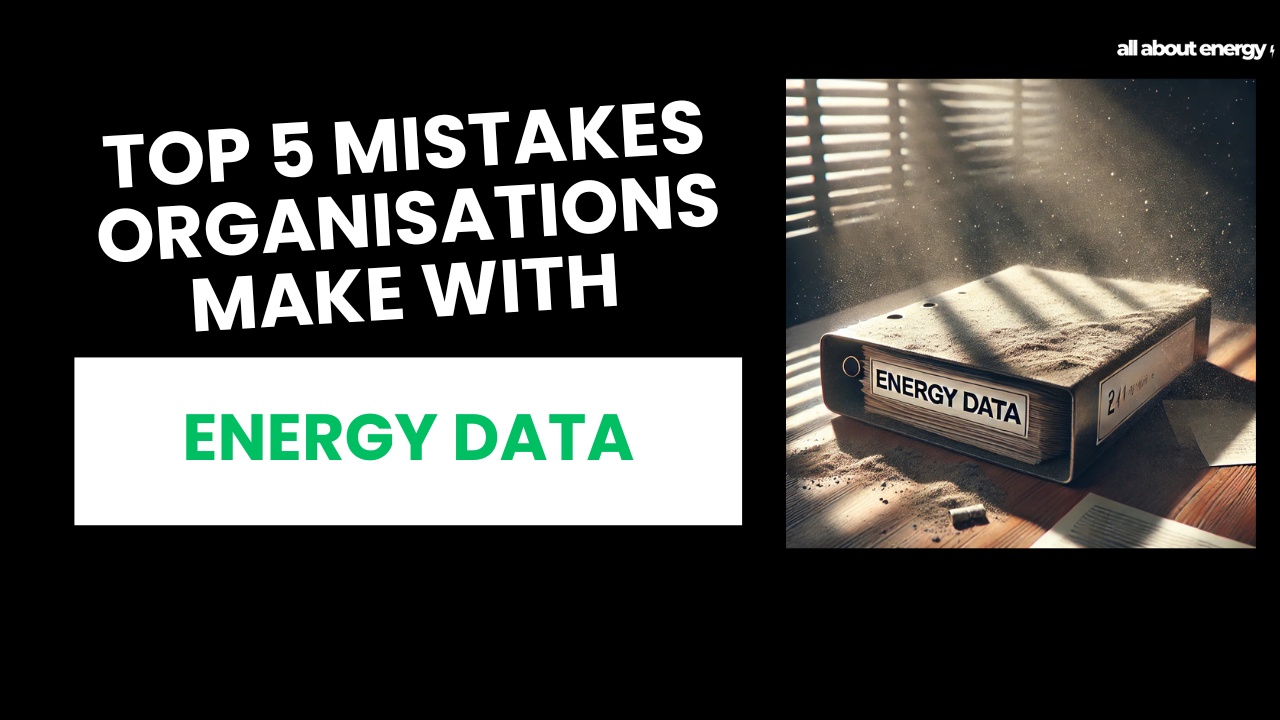Top 5 Mistakes Organisations Make with Energy Data
Written by Joe Wright
Energy data is the foundation of any successful energy management strategy but some organisations make mistakes that limit their ability to optimise their consumption, reduce costs and meet compliance requirements. Don’t be one of them.
The first major one is failing to maintain accurate records of actual consumption. It may sound simple but I’ve seen countless examples where organisations struggle to find or obtain energy data when requested.
They’re often using estimated or incomplete data.
Many businesses base their energy decisions on supplier invoices where available but these fail to provide the granularity which is often needed for detailed insights. Ideally you’d have profile (HH) data, sub metering or a real time monitoring system, without which, identifying specific inefficiencies or anomalies becomes difficult.
Suppliers sometimes have data issues which if unresolved means you’ll struggle to base decisions on the reality of your consumption. I’ve seen examples where organisations estimate consumption but they are not using appropriate estimation techniques which means their figures will bare little resemblance to reality.
If you only have access to invoice data, ensure it’s accurate.
A better solution would be to implement automated data collection and use monitoring systems to ensure accuracy and completeness.
Easily done and well worth doing.
The second mistake is failing to analyse data effectively. Collecting data is one thing, but many organisations store it without extracting meaningful insights. Without clear analysis, trends in energy consumption go unnoticed, and opportunities for savings are missed. Data should be integrated into an energy management system that allows for regular trend analysis, benchmarking, and anomaly detection. You should ensure you have the right expertise, whether in house or through consultants, to interpret the data effectively.
What’s very common is that bills are paid without a second thought. What’s also common is metering systems in place but no one is monitoring the data. Dig a bit deeper and you’ll reap the rewards.
Another mistake is ignoring power quality and demand patterns. Don’t focus solely on total consumption rather than looking at when and how energy is being used. Issues like poor power factor, or excessive peak demand can significantly impact costs and equipment lifespan. Conducting a power quality assessment and implementing solutions such as power factor correction or load shifting can help optimise demand and reduce unnecessary charges.
The fourth mistake is not using data to drive action. Some organisations collect energy data but fail to act on it, rendering the entire process ineffective. Data must inform decision making, whether it’s adjusting operational schedules, optimising equipment performance, or investing in energy efficiency projects.
Setting clear KPIs, regularly reviewing data insights, and establishing accountability within your organisation are crucial to ensuring data leads to tangible improvements.
Finally, the fifth mistake is poor data visibility and accessibility. If energy data is siloed within a single department or only accessible to a handful of people, the potential for organisation wide improvements is lost. Energy management should be a cross functional effort, involving finance, operations, and sustainability teams. Implementing a centralised energy management platform ensures that relevant stakeholders can access and act on the data effectively.
Avoiding these common pitfalls will enable you to transform your energy data into a powerful tool for cost reduction, operational efficiency, and sustainability. By ensuring accurate data collection, leveraging analytics, considering power quality, taking action, and improving accessibility, your organisation can gain the insights it needs to achieve your energy goals, whether they are internal or compliance based.
For those part of the many compliance schemes out there, utilising energy data will always be required so you might as well put systems in place to ensure that energy data is accurate readily available used to drive meaning change.
Are you looking to improve your organisations energy management practices?
Take our Energy Management Scorecard quiz to assess your current strategies and identify areas for improvement. Click below for the free assessment

You May Also Like…
Compliance Simplified
If you’re part of any of the mandatory compliance scheme like SECR, ESOS, or the many others out there, then you...
Why maintenance matters for energy management
When you think about improving your energy management, where does your mind go first? Upgrades? New systems? Cutting...
Creating A Culture Of Energy Efficiency
If your business is subject to compliance schemes like ESOS or SECR, you’re not alone. A lot of the companies I work...




